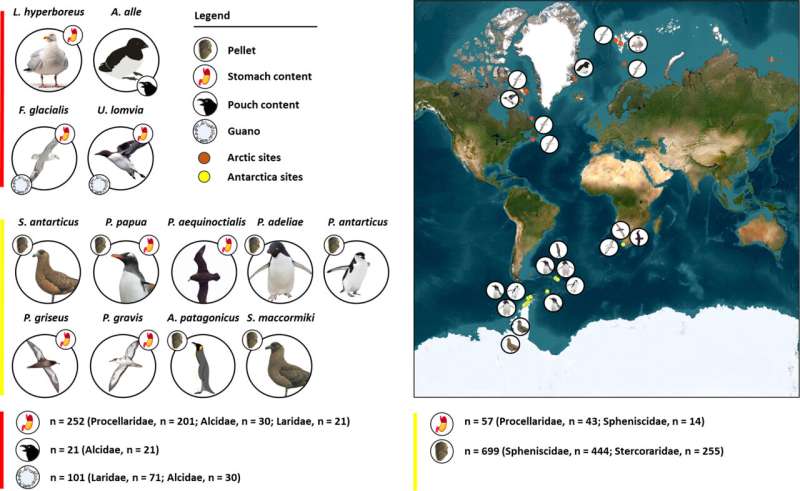
The polar regions of the Arctic and Antarctica are increasingly experiencing the impacts of plastic reaching floating ice and land, not solely as larger macroplastics (>5 cm), but as microplastics (0.1 µm—5 mm) and nanoplastics (<0.1 µm) that may be carried vast distances from their source or be ingested in more populated areas during seasonal migration.
Across >1,100 samples, the researchers explored stomach contents, crop pouch near the throat for temporary food storage during foraging trips, guano (excrement mixture of food and metabolic waste) and regurgitated pellets of undigested food and other particles.
They found that 13 species of seabird inhabiting polar landscapes were reported to have ingested microplastics, including little auks, northern fulmars, glaucous gulls, thick-billed murres, white-chinned petrels, great shearwaters, sooty shearwaters, king penguins, Adélie penguins, chinstrap penguins, gentoo penguins, brown skuas and south polar skuas.
A total of 3,526 particles were extracted from these seabird samples, equating to at least 1 microplastic particle in 90% of Arctic samples and 97% for Antarctica.
Regarding plastic composition, 14 polymer types were identified, the dominant form being polyethylene, followed by polypropylene and polystyrene. These were predominantly present as fragments, derived from the breakdown of larger plastic objects. Such plastic polymer types can be sourced from items like plastic bags, food and drink containers and protective foam packaging.
The impact ingestion of plastic particles can have on seabirds includes blockage of their gastrointestinal tract, toxicity and oxidative stress, as well as triggering immune reactions. Additionally, it is not only direct ingestion of particles that is of concern, as microplastics have been found in krill, a food source for some penguins, highlighting the larger-scale issue in the ecosystem and trophic webs.
Currently, there are 64 and 43 species of seabirds inhabiting the Arctic and Antarctica respectively, but their numbers have been declining over recent years.
Considering the Arctic covers ~6% of Earth’s surface and is comparatively pristine, the implications of human encroachment on the natural world here can be devastating. Beyond plastic pollution, there are additional pressures of expedition tourism, commercial fishing and maritime routes in the North Sea being used more frequently, and the ever-concerning pressure of global warming on melting ice, resulting in temperature, salinity and sea level fluctuations.